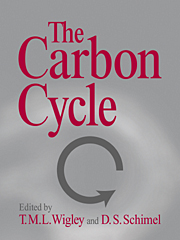Book contents
- Frontmatter
- Contents
- Preface
- Acknowledgments
- Contributors to the 1993 Global Change Institute
- I INTRODUCTION
- II THE MISSING CARBON SINK
- III PALEO-CO2 VARIATIONS
- IV MODELING CO2 CHANGES
- 14 Future Fossil Fuel Carbon Emissions without Policy Intervention: A Review
- 15 The Future Role of Reforestation in Reducing Buildup of Atmospheric CO2
- 16 Simple Ocean Carbon Cycle Models
- 17 Very High Resolution Estimates of Global Ocean Circulation, Suitable for Carbon Cycle Modeling
- 18 Effects of Ocean Circulation Change on Atmospheric CO2
- 19 Box Models of the Terrestrial Biosphere
- 20 Impacts of Climate and CO2 on the Terrestrial Carbon Cycle
- 21 Stabilization of CO2 Concentration Levels
- Part V Appendixes
- Index
15 - The Future Role of Reforestation in Reducing Buildup of Atmospheric CO2
from IV - MODELING CO2 CHANGES
Published online by Cambridge University Press: 04 December 2009
- Frontmatter
- Contents
- Preface
- Acknowledgments
- Contributors to the 1993 Global Change Institute
- I INTRODUCTION
- II THE MISSING CARBON SINK
- III PALEO-CO2 VARIATIONS
- IV MODELING CO2 CHANGES
- 14 Future Fossil Fuel Carbon Emissions without Policy Intervention: A Review
- 15 The Future Role of Reforestation in Reducing Buildup of Atmospheric CO2
- 16 Simple Ocean Carbon Cycle Models
- 17 Very High Resolution Estimates of Global Ocean Circulation, Suitable for Carbon Cycle Modeling
- 18 Effects of Ocean Circulation Change on Atmospheric CO2
- 19 Box Models of the Terrestrial Biosphere
- 20 Impacts of Climate and CO2 on the Terrestrial Carbon Cycle
- 21 Stabilization of CO2 Concentration Levels
- Part V Appendixes
- Index
Summary
Abstract
Among the options proposed for mitigating the buildup of atmospheric CO2 is planting new forest areas to sequester carbon from the atmosphere. One of the questions of interest in modeling the global carbon cycle is the extent to which reforestation is likely to succeed in providing physical removal of CO2 from the atmosphere. There are many strategies for using forest land to mitigate the atmospheric buildup of CO2: decreasing the rate at which forests are cleared for other land uses, increasing the density of carbon storage in existing forests, improving the rate and efficiency at which forest products are used in the place of other energy-intensive products, substituting renewable wood fuels for fossil fuels, improving management of forests and agroforestry, and increasing the amount of land in standing forest. Because increasing the area of forests has social, political, and economic limitations, in addition to physical limitations, it is hard to envision a large increase in forest area except where there are associated economic benefits. Our speculation is that, over the next several decades, (1) the forest strategies most likely to be pursued for the express purpose of CO2 mitigation are those that provide more, or more efficient, substitution of forest products for energy or energy-intensive resources and that (2) the physical accumulation of additional carbon in forests will be of lesser importance.
- Type
- Chapter
- Information
- The Carbon Cycle , pp. 190 - 198Publisher: Cambridge University PressPrint publication year: 2000

